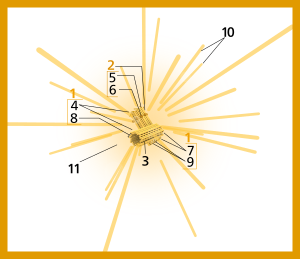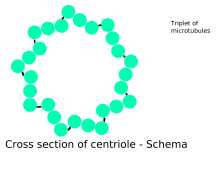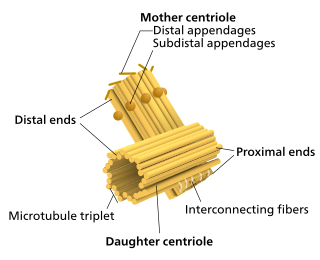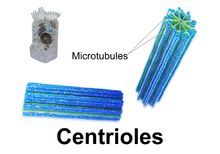Are Centrioles In Plant Or Animal Cells
| Jail cell biology | |
|---|---|
| centrosome | |
 Components of a typical centrosome:
|

Cross-department of a centriole showing its microtubule triplets.
In jail cell biological science a centriole is a cylindrical organelle composed mainly of a poly peptide called tubulin.[ane] Centrioles are found in well-nigh eukaryotic cells, but are not present in conifers (Pinophyta), flowering plants (angiosperms) and most fungi, and are just present in the male gametes of charophytes, bryophytes, seedless vascular plants, cycads, and Ginkgo.[2] [3] A bound pair of centrioles, surrounded past a highly ordered mass of dumbo material, called the pericentriolar material (PCM),[4] makes up a construction called a centrosome.[1]
Centrioles are typically fabricated up of nine sets of short microtubule triplets, arranged in a cylinder. Deviations from this structure include crabs and Drosophila melanogaster embryos, with nine doublets, and Caenorhabditis elegans sperm cells and early embryos, with ix singlets.[5] [6] Additional proteins include centrin, cenexin and tektin.[7]
The main role of centrioles is to produce cilia during interphase and the aster and the spindle during cell segmentation.
History [edit]
The centrosome was discovered jointly by Walther Flemming in 1875 [8] [9] and Edouard Van Beneden in 1876.[10] [ix]Edouard Van Beneden made the showtime observation of centrosomes every bit composed of ii orthogonal centrioles in 1883.[11] Theodor Boveri introduced the term "centrosome" in 1888[12] [9] [13] [14] and the term "centriole" in 1895.[15] [9] The basal torso was named by Theodor Wilhelm Engelmann in 1880.[16] [9] The blueprint of centriole duplication was first worked out independently by Étienne de Harven and Joseph G. Gall c. 1950.[17] [xviii]
Role in prison cell division [edit]

Centrioles are involved in the organization of the mitotic spindle and in the completion of cytokinesis.[xix] Centrioles were previously thought to be required for the germination of a mitotic spindle in animal cells. However, more recent experiments take demonstrated that cells whose centrioles have been removed via light amplification by stimulated emission of radiation ablation can still progress through the Gone phase of interphase before centrioles can exist synthesized subsequently in a de novo fashion.[xx] Additionally, mutant flies lacking centrioles develop unremarkably, although the adult flies' cells lack flagella and cilia and as a issue, they die presently after nativity.[21] The centrioles can self replicate during prison cell division.
Cellular arrangement [edit]
Centrioles are a very important function of centrosomes, which are involved in organizing microtubules in the cytoplasm.[22] [23] The position of the centriole determines the position of the nucleus and plays a crucial role in the spatial organisation of the cell.

3D rendering of centrioles
Fertility [edit]
Sperm centrioles are important for 2 functions:[24] (one) to form the sperm flagellum and sperm movement and (2) for the development of the embryo after fertilization. The sperm supplies the centriole that creates the centrosome and microtubule system of the zygote.[25]
Ciliogenesis [edit]
In flagellates and ciliates, the position of the flagellum or cilium is determined by the mother centriole, which becomes the basal body. An inability of cells to apply centrioles to brand functional flagella and cilia has been linked to a number of genetic and developmental diseases. In particular, the inability of centrioles to properly migrate prior to ciliary assembly has recently been linked to Meckel–Gruber syndrome.[26]
Brute development [edit]

Electron micrograph of a centriole from a mouse embryo.
Proper orientation of cilia via centriole positioning toward the posterior of embryonic node cells is critical for establishing left-correct asymmetry, during mammalian development.[27]
Centriole duplication [edit]
Before DNA replication, cells incorporate ii centrioles, an older mother centriole, and a younger daughter centriole. During jail cell division, a new centriole grows at the proximal stop of both mother and girl centrioles. After duplication, the two centriole pairs (the freshly assembled centriole is now a girl centriole in each pair) will remain fastened to each other orthogonally until mitosis. At that point the mother and daughter centrioles separate dependently on an enzyme chosen separase.[28]
The 2 centrioles in the centrosome are tied to ane some other. The mother centriole has radiating appendages at the distal finish of its long axis and is fastened to its daughter at the proximal stop. Each girl jail cell formed after cell division will inherit one of these pairs. Centrioles offset duplicating when Deoxyribonucleic acid replicates.[19]
Origin [edit]
The last common ancestor of all eukaryotes was a ciliated cell with centrioles. Some lineages of eukaryotes, such every bit land plants, practise not have centrioles except in their motile male gametes. Centrioles are completely absent from all cells of conifers and flowering plants, which do not have ciliate or flagellate gametes.[29] It is unclear if the last common ancestor had one[30] or two cilia.[31] Of import genes such as centrins required for centriole growth, are only found in eukaryotes, and non in leaner or archaea.[xxx]
Etymology and pronunciation [edit]
The word centriole () uses combining forms of centri- and -ole, yielding "little cardinal part", which describes a centriole'due south typical location about the eye of the cell.
Singular centrioles [edit]
Typical centrioles are fabricated of 9 triplets of microtubules organized with radial symmetry.[32] Centrioles tin vary the number of microtubules and tin can exist made of ix doublets of microtubules (equally in Drosophila melanogaster) or ix singlets of microtubules every bit in C. elegans. Singular centrioles are centrioles that exercise not have microtubules, such as the Proximal Centriole-Like found in D. melanogaster sperm,[33] or that have microtubules with no radial symmetry, such as in the distal centriole of human spermatozoon.[34] Atypical centrioles may have evolved at least eight times independently during vertebrate evolution and may evolve in the sperm after internal fertilization evolves.[35]
Information technology wasn't clear why centriole become atypical until recently. The atypical distal centriole forms a dynamic basal complex (DBC) that, together with other structures in the sperm neck, facilitates a cascade of internal sliding, coupling tail beating with head kinking. The singular distal centriole'southward properties suggest that it evolved into a transmission organization that couples the sperm tail motors to the whole sperm, thereby enhancing sperm function.[36]
References [edit]
- ^ a b Eddé, B; Rossier, J; Le Caer, JP; Desbruyères, Eastward; Gros, F; Denoulet, P (1990). "Posttranslational glutamylation of alpha-tubulin". Science. 247 (4938): 83–five. Bibcode:1990Sci...247...83E. doi:ten.1126/science.1967194. PMID 1967194.
- ^ Quarmby, LM; Parker, JD (2005). "Cilia and the cell bicycle?". The Journal of Prison cell Biology. 169 (five): 707–10. doi:10.1083/jcb.200503053. PMC2171619. PMID 15928206.
- ^ Silflow, CD; Lefebvre, PA (2001). "Assembly and move of eukaryotic cilia and flagella. Lessons from Chlamydomonas reinhardtii". Constitute Physiology. 127 (4): 1500–1507. doi:x.1104/pp.010807. PMC1540183. PMID 11743094.
- ^ Lawo, Steffen; Hasegan, Monica; Gupta, Gagan D.; Pelletier, Laurence (Nov 2012). "Subdiffraction imaging of centrosomes reveals higher-order organizational features of pericentriolar material". Nature Cell Biology. 14 (11): 1148–1158. doi:10.1038/ncb2591. ISSN 1476-4679. PMID 23086237. S2CID 11286303.
- ^ Delattre, M; Gönczy, P (2004). "The arithmetic of centrosome biogenesis" (PDF). Journal of Cell Science. 117 (Pt 9): 1619–thirty. doi:10.1242/jcs.01128. PMID 15075224. S2CID 7046196.
- ^ Leidel, S.; Delattre, M.; Cerutti, L.; Baumer, One thousand.; Gönczy, P (2005). "SAS-6 defines a protein family required for centrosome duplication in C. elegans and in man cells". Nature Cell Biology. 7 (2): 115–25. doi:10.1038/ncb1220. PMID 15665853. S2CID 4634352.
- ^ Rieder, C. L.; Faruki, S.; Khodjakov, A. (October 2001). "The centrosome in vertebrates: more than a microtubule-organizing center". Trends in Cell Biological science. 11 (10): 413–419. doi:10.1016/S0962-8924(01)02085-2. ISSN 0962-8924. PMID 11567874.
- ^ Flemming, W. (1875). Studien uber die Entwicklungsgeschichte der Najaden. Sitzungsgeber. Akad. Wiss. Wien 71, 81–147
- ^ a b c d east Bloodgood RA. From central to rudimentary to primary: the history of an underappreciated organelle whose time has come. The main cilium. Methods Cell Biol. 2009;94:3-52. doi: 10.1016/S0091-679X(08)94001-2. Epub 2009 December 23. PMID 20362083.
- ^ Van Beneden, Due east. (1876). Contribution a l'histoire de la vesiculaire germinative et du premier noyau embryonnaire. Bull. Acad. R. Belg (2me series) 42, 35–97.
- ^ Wunderlich, V. (2002). "JMM - Past and Present". Journal of Molecular Medicine. 80 (9): 545–548. doi:10.1007/s00109-002-0374-y. PMID 12226736.
- ^ Boveri, T. (1888). Zellen-Studien II. Die Befruchtung und Teilung des Eies von Ascaris megalocephala. Jena. Z. Naturwiss. 22, 685–882.
- ^ Boveri, T. Ueber das Verhalten der Centrosomen bei der Befruchtung des Seeigel-Eies nebst allgemeinen Bemerkungen über Centrosomen und Verwandtes. Verh. d. Phys.-Med. Ges. zu Würzburg, N. F., Bd. XXIX, 1895. link.
- ^ Boveri, T. (1901). Zellen-Studien: Uber die Natur der Centrosomen. Four. Fischer, Jena. link.
- ^ Boveri, T. (1895). Ueber dice Befruchtungs und Entwickelungsfahigkeit kernloser Seeigeleier und uber dice Moglichkeit ihrer Bastardierung. Curvation. Entwicklungsmech. Org. (Wilhelm Roux) 2, 394–443.
- ^ Engelmann, T. W. (1880). Zur Anatomie und Physiologie der Flimmerzellen. Pflugers Arch. 23, 505–535.
- ^ Wolfe, Stephen L. (1977). Biology: the foundations (First ed.). Wadsworth. ISBN9780534004903.
- ^ Vorobjev, I. A.; Nadezhdina, E. S. (1987). The Centrosome and Its Role in the Arrangement of Microtubules. International Review of Cytology. Vol. 106. pp. 227–293. doi:ten.1016/S0074-7696(08)61714-three. ISBN978-0-12-364506-7. PMID 3294718. . Come across also de Harven'southward own recollections of this work: de Harven, Etienne (1994). "Early on observations of centrioles and mitotic spindle fibers by transmission electron microscopy". Biology of the Jail cell. 80 (2–3): 107–109. doi:x.1111/j.1768-322X.1994.tb00916.10. PMID 8087058. S2CID 84594630.
- ^ a b Salisbury, JL; Suino, KM; Busby, R; Springett, Chiliad (2002). "Centrin-two is required for centriole duplication in mammalian cells". Electric current Biology. 12 (15): 1287–92. doi:10.1016/S0960-9822(02)01019-9. PMID 12176356. S2CID 1415623.
- ^ La Terra, Southward; English, CN; Hergert, P; McEwen, BF; Sluder, G; Khodjakov, A (2005). "The de novo centriole assembly pathway in HeLa cells: jail cell bicycle progression and centriole assembly/maturation". The Journal of Cell Biology. 168 (5): 713–22. doi:ten.1083/jcb.200411126. PMC2171814. PMID 15738265.
- ^ Basto, R; Lau, J; Vinogradova, T; Gardiol, A; Woods, CG; Khodjakov, A; Raff, JW (2006). "Flies without centrioles". Cell. 125 (seven): 1375–86. doi:10.1016/j.cell.2006.05.025. PMID 16814722. S2CID 2080684.
- ^ Feldman, JL; Geimer, South; Marshall, WF (2007). "The mother centriole plays an instructive role in defining jail cell geometry". PLOS Biology. 5 (half dozen): e149. doi:10.1371/journal.pbio.0050149. PMC1872036. PMID 17518519.
- ^ Beisson, J; Wright, M (2003). "Basal body/centriole assembly and continuity". Current Stance in Cell Biological science. 15 (ane): 96–104. doi:10.1016/S0955-0674(02)00017-0. PMID 12517710.
- ^ Avidor-Reiss, T., Khire, A., Fishman, E. 50., & Jo, Grand. H. (2015). Atypical centrioles during sexual reproduction. Frontiers in prison cell and developmental biology, 3, 21. Chicago
- ^ Hewitson, Laura & Schatten, Gerald P. (2003). "The biological science of fertilization in humans". In Patrizio, Pasquale; et al. (eds.). A colour atlas for human assisted reproduction: laboratory and clinical insights. Lippincott Williams & Wilkins. p. 3. ISBN978-0-7817-3769-two . Retrieved ix November 2013.
- ^ Cui, Cheng; Chatterjee, Bishwanath; Francis, Deanne; Yu, Qing; SanAgustin, Jovenal T.; Francis, Richard; Tansey, Terry; Henry, Charisse; Wang, Baolin; Lemley, Bethan; Pazour, Gregory J.; Lo, Cecilia W. (2011). "Disruption of Mks1 localization to the mother centriole causes cilia defects and developmental malformations in Meckel-Gruber syndrome". Dis. Models Mech. 4 (one): 43–56. doi:10.1242/dmm.006262. PMC3008963. PMID 21045211.
- ^ Babu, Deepak; Roy, Sudipto (i May 2013). "Left–right asymmetry: cilia stir up new surprises in the node". Open Biology. iii (5): 130052. doi:10.1098/rsob.130052. ISSN 2046-2441. PMC3866868. PMID 23720541.
- ^ Tsou, MF; Stearns, T (2006). "Machinery limiting centrosome duplication to once per cell cycle". Nature. 442 (7105): 947–51. Bibcode:2006Natur.442..947T. doi:10.1038/nature04985. PMID 16862117. S2CID 4413248.
- ^ Marshall, W.F. (2009). "Centriole Evolution". Electric current Opinion in Cell Biology. 21 (1): fourteen–19. doi:ten.1016/j.ceb.2009.01.008. PMC2835302. PMID 19196504.
- ^ a b Bornens, Grand.; Azimzadeh, J. (2007). "Origin and Evolution of the Centrosome". Eukaryotic Membranes and Cytoskeleton. Advances in Experimental Medicine and Biology. Vol. 607. pp. 119–129. doi:ten.1007/978-0-387-74021-8_10. ISBN978-0-387-74020-1. PMID 17977464.
- ^ Rogozin, I. B.; Basu, Grand. K.; Csürös, M.; Koonin, E. V. (2009). "Assay of Rare Genomic Changes Does Not Support the Unikont-Bikont Phylogeny and Suggests Cyanobacterial Symbiosis as the Point of Primary Radiation of Eukaryotes". Genome Biological science and Evolution. 1: 99–113. doi:10.1093/gbe/evp011. PMC2817406. PMID 20333181.
- ^ Avidor-Reiss, Tomer; Gopalakrishnan, Jayachandran (2013). "Building a centriole". Current Stance in Cell Biology. 25 (1): 72–7. doi:ten.1016/j.ceb.2012.10.016. PMC3578074. PMID 23199753.
- ^ Blachon, South; Cai, X; Roberts, K. A; Yang, K; Polyanovsky, A; Church, A; Avidor-Reiss, T (2009). "A Proximal Centriole-Similar Structure is Present in Drosophila Spermatids and Tin can Serve as a Model to Report Centriole Duplication". Genetics. 182 (1): 133–44. doi:10.1534/genetics.109.101709. PMC2674812. PMID 19293139.
- ^ Fishman, Emily 50; Jo, Kyoung; Nguyen, Quynh P. H; Kong, Dong; Royfman, Rachel; Cekic, Anthony R; Khanal, Sushil; Miller, Ann 50; Simerly, Calvin; Schatten, Gerald; Loncarek, Jadranka; Mennella, Vito; Avidor-Reiss, Tomer (2018). "A novel atypical sperm centriole is functional during human fertilization". Nature Communications. 9 (one): 2210. Bibcode:2018NatCo...nine.2210F. doi:10.1038/s41467-018-04678-8. PMC5992222. PMID 29880810.
- ^ Turner, Grand., Northward. Solanki, H.O. Salouha, and T. Avidor-Reiss. 2022. Atypical Centriolar Composition Correlates with Internal Fertilization in Fish. Cells. 11:758, https://www.mdpi.com/2073-4409/xi/five/758
- ^ Khanal, S., 1000.R. Leung, A. Royfman, E.Fifty. Fishman, B. Saltzman, H. Bloomfield-Gadelha, T. Zeev-Ben-Mordehai, and T. Avidor-Reiss. 2021. A dynamic basal circuitous modulates mammalian sperm movement. Nat Commun. 12:3808.. https://doi.org/ten.1038/s41467-021-24011-0
Source: https://en.wikipedia.org/wiki/Centriole
Posted by: maysracion.blogspot.com

0 Response to "Are Centrioles In Plant Or Animal Cells"
Post a Comment